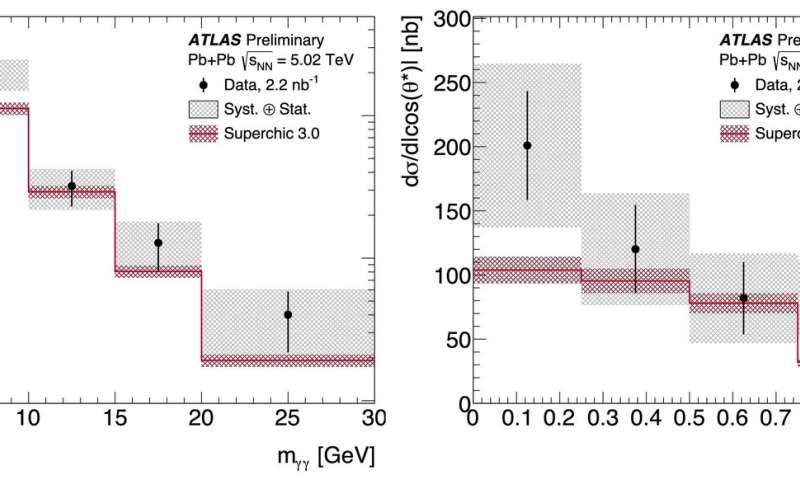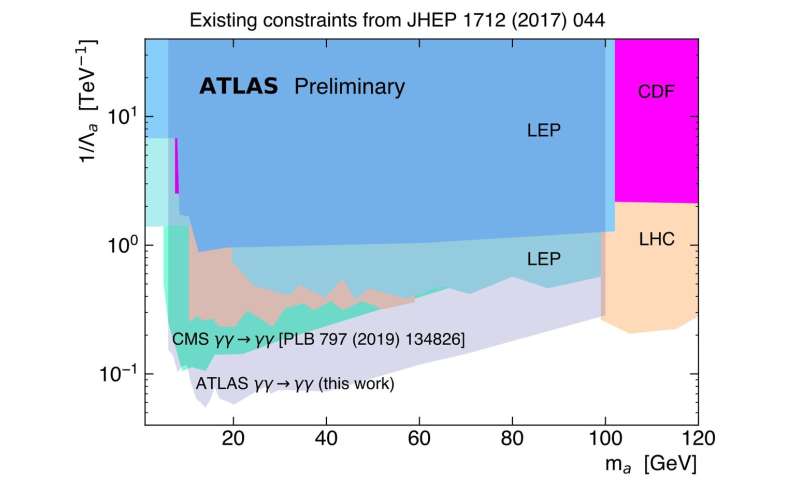
Light-by-light scattering is a rare phenomenon in which two photons—particles of light—interact, producing another pair of photons. Direct observation of this process at high energy had proven elusive for decades, until it was first seen by the ATLAS Experiment in 2016 and established in 2019. In a new measurement, ATLAS physicists are using light-by-light scattering to search for a hyped phenomenon beyond the Standard Model of particle physics: axion-like particles.
Collisions of heavy lead ions in the Large Hadron Collider (LHC) provide the ideal environment to study light-by-light scattering. As bunches of lead ions are accelerated, an enormous flux of surrounding photons is generated corresponding to an electrical field with strength of up to 1025 volt per metre. When ions from opposite beams pass next to each other at the centre of the ATLAS detector, their surrounding photons can interact and scatter off one another. Because the lead ions lose only a tiny fraction of their energy in this process, the outgoing ions continue their path around the LHC ring, unseen by the ATLAS detector. These interactions are known as ultra-peripheral collisions. This leads to a distinct event signature, very unlike typical lead ion collision events, with two back-to-back photons and no further activity in the detector.
Based on lead-lead collision data recorded in 2015, the ATLAS Collaboration found the first direct evidence of high-energy light-by-light scattering. More recently the ATLAS Collaboration reported the observation of light-by-light scattering with a significance of 8.2 standard deviations, using a large data sample taken in 2018.

The ATLAS Collaboration has studied the full LHC Run-2 dataset of heavy-ion collisions to measure light-by-light scattering with improved precision and more detail. Out of the more than hundred billion ultra-peripheral collisions probed, ATLAS observed a total of 97 candidate events while 27 events are expected from background processes. In addition to the production rate (cross section), ATLAS measured the energies and angular distributions of the produced photons (i.e. their kinematics). The result explores a broader range of diphoton masses, increasing the expected signal yield by about 50% in comparison to the previous ATLAS measurements.
The measurement of light-by-light scattering is sensitive to processes beyond the Standard Model, such as axion-like particles. These are hypothetical spin-less (scalar) particles with an odd parity quantum number (the Higgs boson, for example, is a scalar with even parity) and typically weak interactions with Standard Model particles. In the new ATLAS result, physicists considered whether the pairs of interacting photons produce axion-like particles (a) as they scatter off each other (γγ → a → γγ), which would lead to an excess of scattering events with diphoton mass equal to the mass of a. They examined the diphoton mass distribution for a mass range for a between 6 and 100 GeV. No significant excess of events over the expected background was found in the analysis. ATLAS physicists were able to derive, at a 95% confidence level, an exclusion bound of the axion-like particles coupling to photons (Figure 2). Assuming 100% of the putative particles decay to photons, this new analysis places the strongest existing limits on the production of axion-like particles in the examined mass range to date.
With the much larger dataset expected in the future LHC runs, physicists will continue to explore the sensitivity of light-by-light scattering to phenomena beyond the Standard Model.
Explore further
Citation: ATLAS Experiment measures light scattering on light and constrains axion-like particles (2020, June 19) retrieved 19 June 2020 from https://ift.tt/2Yei4vC
This document is subject to copyright. Apart from any fair dealing for the purpose of private study or research, no part may be reproduced without the written permission. The content is provided for information purposes only.
"light" - Google News
June 19, 2020 at 09:24PM
https://ift.tt/2Yei4vC
ATLAS Experiment measures light scattering on light and constrains axion-like particles - Phys.org
"light" - Google News
https://ift.tt/2Wm8QLw
https://ift.tt/2Stbv5k
Bagikan Berita Ini














0 Response to "ATLAS Experiment measures light scattering on light and constrains axion-like particles - Phys.org"
Post a Comment